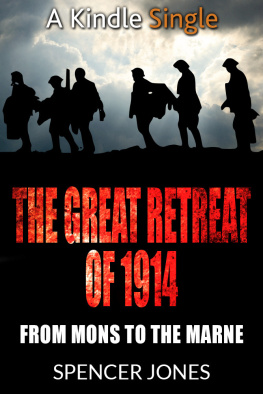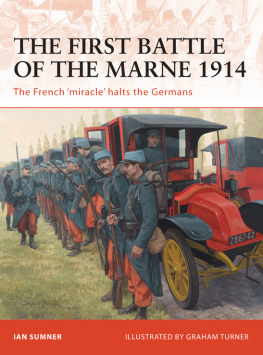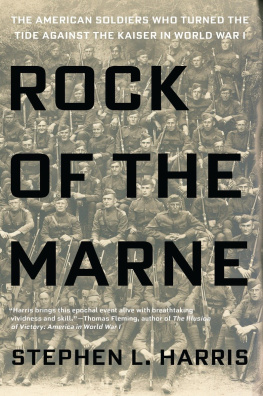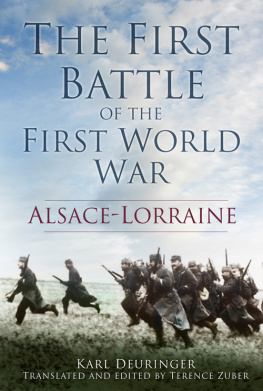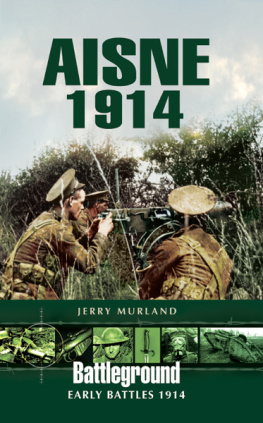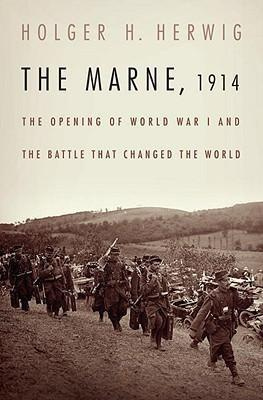Title page
Walking the Retreat
The March to the Marne: 1914 Revisited
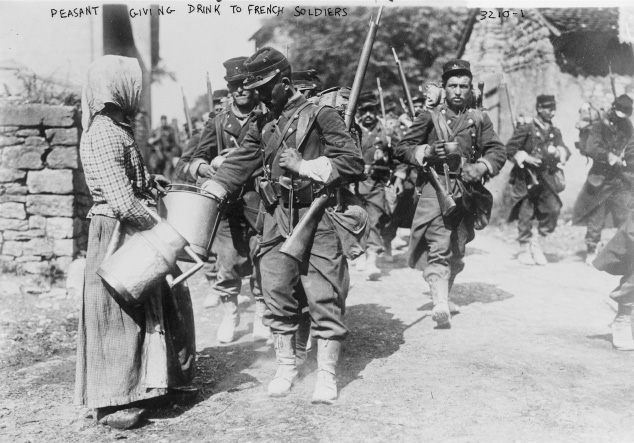
Terry Cudbird
Signal Books
Oxford
Publisher information
First published in 2014 by
Signal Books Limited
36 Minster Road
Oxford
OX4 1LY
www.signalbooks.co.uk
Terry Cudbird, 2014
The right of Terry Cudbird to be identified as the author of this work has been asserted by him in accordance with the Copyright, Design and Patents Act, 1988.
All rights reserved. The whole of this work, including all text and illustrations, is protected by copyright. No parts of this work may be loaded, stored, manipulated, reproduced or transmitted in any form or by any means, electronic or mechanical, including photocopying and recording, or by any information, storage and retrieval system without prior written permission from the publisher, on behalf of the copyright owner.
2015 digital version by Andrews UK Limited
www.andrewsuk.com
Production: Tora Kelly
Cover design: Baseline Arts, Oxford
Cover illustrations: Military Images/Alamy;
Baseline Arts, Oxford
Title page image: Peasant girl feeding passing French troops in 1914. (Library of Congress, Washington DC)
Maps: Mike Reading, Hello Design

Carving of General Joffre and a French soldier, monument commemorating the Victory of the Marne, Mondemont. (Terry Cudbird)
Introduction: The First Battle of the Marne September 1914
The route dpartementale rose smoothly up a steep incline deep in rural France. I had not seen another human being for some time. Ploughed fields and woods divided the landscape into a patchwork quilt. It was early in March and crests of hard-packed snow still covered the verges. The light was flat late in the afternoon. Nothing remarkable here, I thought. A narrow farm road led to a ridge. To my left the ground fell away quite steeply to a valley floor. Away to the east orderly fields gave way to dense vegetation, crossed by water channels, suggesting marshy ground. Just visible even further to my right stretched the bleak plain of la Champagne pouilleuse (the infertile Champagne), dead flat as far as the eye could see, earth stripped of vegetation, wisps of its light chalk soil raised by the wind.
The bitter northern wind stung my face forcing me to wrap my scarf more tightly around my neck for protection. I turned round and was surprised to see what looked like a massive carved menhir of recent date. Its bulk and height looked incongruous, towering over some small buildings, the walls of an old manor house and ancient woods. On top of the hill it must have been visible for miles around. Clearly someone was trying to make sure no visitor would forget it. Enormous carved figures covered the bottom half facing down hill; nine military men, generals most of them to judge by their head gear. The largest in the centre had his left arm around an ordinary soldier in a longer heavier coat than his august colleagues. The inscription above told me that I had found the monument to commemorate the Battle of the Marne, September 1914.
So here they were: the men I had first read about in Barbara Tuchmans Pulitzer prize-winning book The Guns of August . Joseph Jacques Csaire Joffre, the French Commander-in-Chief, stands in the centre. The son of a vigneron from Rivesaltes near Perpignan, he was a man of some bulk who clearly enjoyed his food. Stolid and unflappable, his staff knew they could always find him at lunch time in some station buffet. The soldier next to him represents a poilu , or hairy one, because he had no time to shave. There were around one million of them fighting from the Gates of Paris to the Vosges Mountains in Alsace. It was Joffres job to manoeuvre them into the right positions, but they were seen as the real heroes. On either side are the generals who were most directly involved, starting on the right with Joseph Gallini, the Military Governor of Paris, and Michel-Joseph Manoury whose Sixth Army opened the battle by launching an attack on the German right flank. When the attack faltered some reinforcements were rushed to the front in a fleet of taxis. Next to him stands a figure in a different uniform and most noticeably a peaked cap, rather than the pillbox kpi beloved of the French army. He outranks all the others; Field-Marshal Sir John French, commander of the British Expeditionary Force, a choleric cavalryman who stood on his dignity and struggled to get his tongue round the French language. Then comes Louis Franchet dEsperey, the fierce and energetic leader of the Fifth Army, known as Desperate Frankie to the British. To the left of Joffre is Ferdinand Foch, future Allied commander-in-chief in 1918. His army occupied the central position and kept the Germans back against all the odds. After Foch come two generals whose armies stretched from Vitry-le-Franois across the plain and all the way north along the Ctes de Meuse to the fortress of VerdunFerdinand Langle de Cary commanding the Fourth Army and Maurice Sarrail the Third Army, both loyal Republicans.
*
When I got back home I started to study the first month of the Great War in more detail. One question above all others kept coming to mind as I read. Why did the German Army, which entered the war with such a high reputation, fail to knock France out of it in the first weeks of the conflict? That had been its planto defeat France quickly before focusing its main effort on Russia. The Germans invaded Belgium, aiming to outflank the French and British Armies. The French on the other hand concentrated the bulk of their forces along the frontier between the Meuse river and the Vosges Mountains. The Allied dispositions seemed to favour the German plans.
In the fighting of August 1914, known as the Battle of the Frontiers, badly prepared French attacks on the German centre in Lorraine and the Ardennes resulted in terrible losses for the French armies. Further west the French Fifth Army was driven back at Charleroi in southern Belgium. The British Expeditionary Force (BEF) had to fight the numerically superior German First Army at Mons and then retire. The threat from the weight of the German right wing and the early losses caused the Allies to fall back. Their retreat lasted for two weeks from 23 August until 5 September. During this period the French changed their strategy in Lorraine to a defensive one, using well-fortified positions to repel German attacks. This posture enabled them to move substantial forces from the east and create a new army west of Paris on the German right flank. The Allied retreat came to a halt south of the Marne, when the French launched an attack on the German First Army out of Paris, supported by the other French armies and the BEF. The Battle of the Marne lasted from 6 to 9 September. It ended when the Germans decided to withdraw because they feared an Allied thrust through the yawning gap between their First and Second Armies. The German armies retreated to prepared defensive positions north of the River Aisne, from which the Allies were unable to dislodge them. Gradually both sides dug into the ground, creating a line of trenches from the Channel to the Swiss frontier. The Germans had failed to knock the French out of the war.
The retreat to the Marne was a planned withdrawal, not a rout. The Allied armies suffered heavy losses in the Battle of the Frontiers but they were not defeated. The bulk of their formations, together with their guns and equipment, were intact. The Germans took plenty of prisoners but not in the numbers they might have expected. Conditions during the retreat were chaotic at times with units separated from each other and supplies disrupted, but there was a planto fall back, recover, re-group and eventually strike back. The front line was fluid and permeable, with the German cavalry frequently moving ahead of scattered Allied units. Generally, however, the Allies kept ahead of the German armies and they fought a series of delaying actionsat Le Cateau, Guise, Villers-Cottertsso that the majority of their forces could get away. If you read the diaries of Allied soldiers and officers you often come across discouragement, fear and anxiety, but never a sense that the game was up. Sometimes the troops ran but mostly they trudged south following orders. When Frances new force was assembled outside Paris the retreating soldiers turned round and attacked the scattered spearheads of the German armies.
Next page

